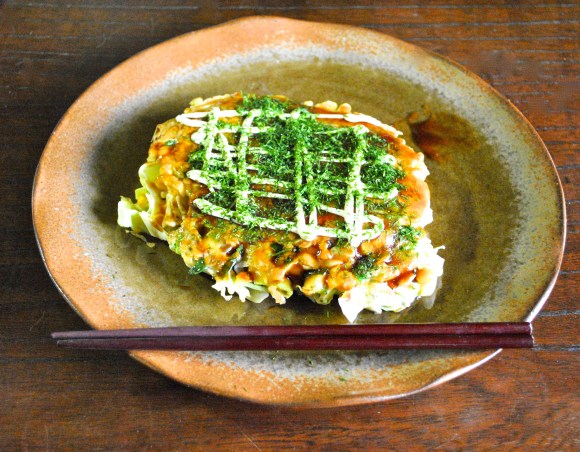
Okonomiyaki is one of the most popular foods cooked at home in Japan. One of Japan’s Top 10 Comfort Foods, the dish is fun to make with family or friends and best of all, it’s easy! Okonomiyaki is also popular with foreigners who when visiting Japan can sample the dish at any of the myriad specialty restaurants dedicated to this vegetable-rich meal.
So, what exactly is okonomiyaki? And how do you make it? Glad you asked!
Read on to find out more about this simple dish: watch a how-to video showing you how to make it, check out photos that show you some unusual ingredients, and get inside tips from Kazuko who regularly makes the dish for her seven grandchildren.
I recently saw this food defined as “pan-fried batter cake,” but don’t be fooled. It has nothing to do with baseball. Or cake. A vegetable pancake would be the closest description, but you can make the dish with or without meat. While it took me forever to learn how to pronounce the dish’s name (o-koh-no-me-ya-key お好み焼き) when I first came to Japan (I could only reproduce the word was by thinking of the Spanish “economia” and adding ki) it is easier to grasp once you understand a bit of Japanese.
Konomi means “your liking” , and is given the polite “o” that we often see placed in front of words like “obento” (boxed lunch) and “ofuro” (bath). The yaki part means “grilled.” Think tako-yaki (grilled octopus), yaki-tori (grilled chicken) and yaki imo (grilled sweet potato). Okonomi refers to the way it is prepared: to your liking, or in simpler terms “as you like it.” This results in no-rules-okonomiyaki, a great feast for anyone who loves to embellish recipes. And that’s pretty much everyone, right?
In order to get the very best advice on how to cook this no-holds-barred, anything goes dish, however, I decided to turn to a pro: my neighbor Kazuko.
I’ve lived next-door to Kazuko for almost 20 years and we’ve been through a lot together: her daughters’ weddings, family funerals, dog and cat-sitting, and now an array of grandchildren who come and go over the holidays. Her culinary skills have developed over many years and I have been a beneficiary as she has cooked for me as if I were another member of her family. And she cooks with ingredients straight from her vegetable garden!
So when I asked her to teach us here at RocketNews24 how to make okonomiyaki at home, she was happy to oblige, and brought over appliances and implements to my kitchen to make Kansai-style version. As I document our culinary mission, I’ve added some of her personal tips for making successful okonomiyaki. In the video, you can watch as Kazuko makes the dish herself.
What you’ll need
Restaurants cook okonomiyaki on a teppan grill, but most Japanese people have an electric grill they use at home on which they can make two or more pancakes at the same time. You can also use a frying pan and make them one at a time if you don’t mind waiting a little longer between “courses.” You’ll need a mixing bowl for the ingredients, a large spoon and two spatulas.
Ingredients:
You’ll need eggs, okonomiyaki flour, and cabbage and scallions make up the bulk of the mix. Most people will add more things, such as shredded carrot, mochi, corn, squid, shrimp or really, anything at all, or, “as you like it!” If it feels right, add it!
The toppings consist of okonomiyaki sauce (sweet and sticky), nori seaweed and dried bonito flakes. These are the basic toppings but you can add or subtract them as you like. Mayonnaise is also a very popular topping, preferably out of a squeeze bottle so you can make fun criss-cross patterns on top (see video at the end of the article).
At the end of the article we also have a photo of the ingredients still in their packages, so you’ll know what to buy at the store.
Here are the dry ingredients you’ll need.
▼Clockwise from top-left: katsuo bushi (dried bonito flakes), okonomiyaki flour, nori (seaweed) and okonomiyaki sauce.
These are the fresh ingredients you’ll need. Feel free to add whatever you like too.
▼Negi (scallions), egg, thin cuts of pork belly, and cabbage. We also added yamaimo, which is the long, brown root vegetable.
Preparing the Ingredients:
For two people (one pancake each) the recommended portions of ingredients are: one cup of okonomiyaki flour, 3/4 cup of water, one egg, 300 grams of cabbage, a few scallions (chopped, including the tops) and pork (one slice for each pancake). But if that’s not easy enough for you, just eyeball it and make it “as you like!”
Kazuko’s Tip No. 1: Instead of water, use dashi (Japanese soup stock) for a richer blend.
We made enough okonomiyaki for three people and used one half of a cabbage (shredded), two eggs, four scallions (use the tops too), unmeasured handfuls of okonomiyaki flour, a cup of corn, some dashi and a chunk of yamaimo.
Yamaimo, a tuber, goes by the formal name of Dioscorea polystachya. It’s slimy and kinda disgusting when eaten raw (it makes your mouth itch) but don’t worry, you won’t get that sensation when it’s mixed into okonomiyaki. If you’re new to yamaimo, you’ll need some instructions.
▼First, take the skin off the potato with a regular potato peeler or a fruit peeling knife. Next you’re going to grate it.
▼You can use a traditional box grater, but the Japanese graters with these funky holes work much better.
▼The yamaimo will be slippery in your hands but it’s very soft so will grate easily and quickly. It will also turn into a gooey liquid, which is good! It’s used as a binding agent, like raw eggs, so actually adds to the texture of okonomiyaki. I know, hard to believe.
If you you’re a vegetarian or don’t want to use eggs in your batter, be sure to use yamaimo to bond the mixture.
Mixing the Batter
Put the cabbage, okonomiyaki flour, eggs, water or dashi, scallions, and all the other vegetables you’ve chosen into a large bowl and mix with a spoon.
▼The consistency should ultimately look like this, with a coating of batter visible on the vegetables.
Cooking the Okonomiyaki
Japanese electric hot plates have a special okonomiyaki setting, but you can put your element on medium heat and that should do the job. You’ll have to adjust the temperature and amount of cooking time accordingly; chunky vegetables and meat will take longer to cook so may need lower heat.
When the skillet is hot and ready to please, place a few ladles of the mixture onto the grill for each pancake. The pancake will be very thick and a bit unruly, but give it time and as the cabbage cooks, it will soften and the pancake will flatten out as it gets thinner. Don’t be tempted to press down onto the pancake with your spatula – some gentle shaping is fine, but too much pressure will result in a heavy, stodgy pancake.
Kazuko’s Tip No. 2: Some people put the pork on the grill first, placing the ladles of batter and veggie mixture on top of it. Kazuko suggests, however, putting the meat in the middle of the pancake. Meat cooked on the inside of the mixture will be softer, she says. On the newer griddles, you shouldn’t need oil but if you’re using a frying pan, you can add a tiny drop of vegetable oil if you want.
▼We’ve made two pancakes, one meatless and one with meat.
▼Once the meat is placed on the pancake, add another dollop of cabbage mixture to cover it up.
You should have at least one spatula in your hand at all times so you can check the underside of the pancake to see how it is cooking and to make sure it isn’t sticking. Continue to give it love taps on the sides (see video) to keep it together and make sure the nice round shape is maintained.
Flipping the Pancake
When the bottom of the pancake looks golden brown, it is ready for a flip to cook the other side. This is the tricky part! Try to flip the pancake without breaking it into two (or more) pieces. Use two spatulas.
Kazuko’s Tip No. 3: If you’re having problems pulling off a successful flip, it may be because your batter is too thin. Add more okonomiyaki flour.
▼Nice flip job! Now you’ll need more love taps on the sides to regain the roundness.
Adding the Toppings
After more gentle taps and bottom checks, when the second side is golden and the meat has cooked thoroughly, use the two spatulas to take the okonomiyaki off the hot plate and put it on a dish.
Kazuko’s Tip No. 4: If your okonomiyaki is taking too long to cook all the way through, next time cut the cabbage into thinner slices so that it doesn’t take so long to cook. Smaller pieces of cabbage will also be easier for children and the elderly to eat.
▼Now, ready for toppings!
The Japanese always brush on okonomiyaki sauce with a special brush (see video) but if you don’t have one, you can just pour it on and smooth it over with a spoon.
▼Next, layer the seaweed and katsuo flakes on top.
Some people choose to add mayonnaise (see video) or use a combination of toppings.
▼Tadaaaaaa! Ready to eat.
And you’re all done!
Here’s the cooking process in a super-speedy video. Be sure to add it to your favorites for easy reference later!
Thanks for joining us in the RocketKitchen! Now you are ready to make okonomiyaki as its name implies – as you like it! If you find some unusual but tasty ingredient, please let us know in the comments section!
▼Packaged ingredients, left to right: Katsuo bushi, okonomiyaki sauce, nori seaweed, okonomiyaki flour.
If you like okonomiyaki, you’ll surely like monjayaki too. Learn how to make it!
All images © Amy Chavez/SoraNews24

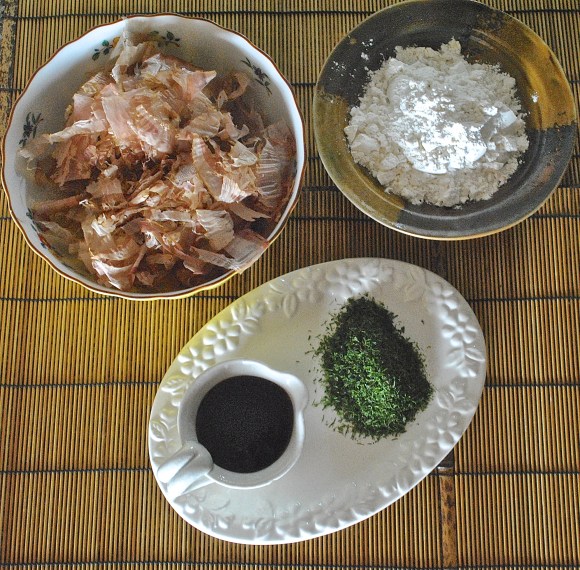
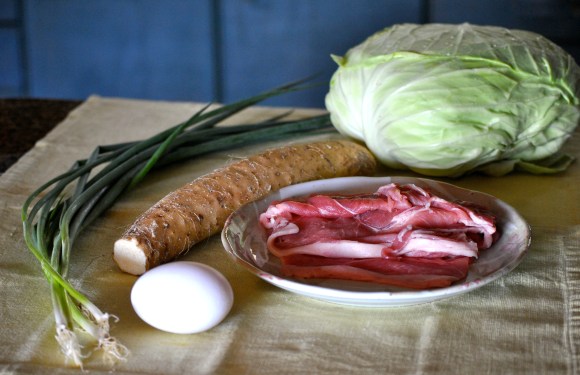
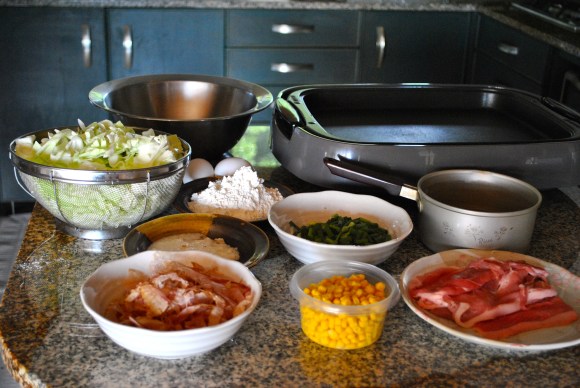
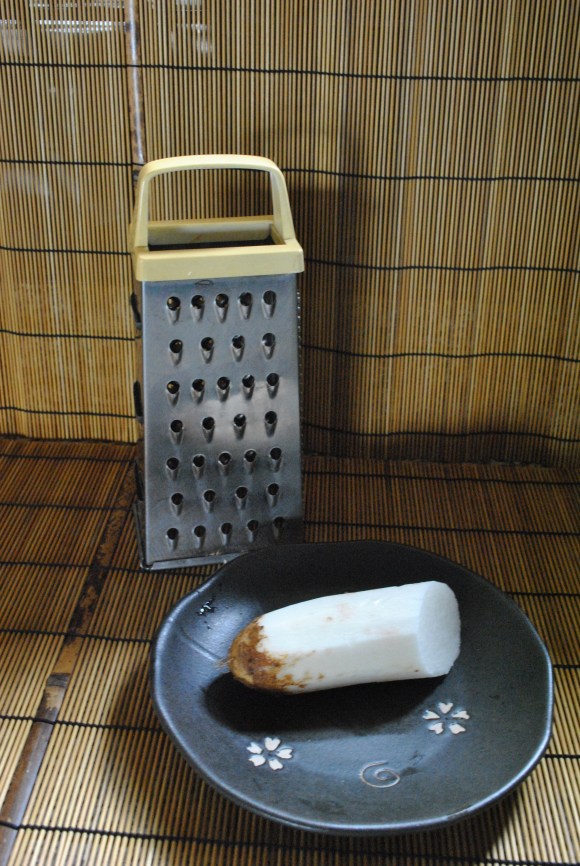
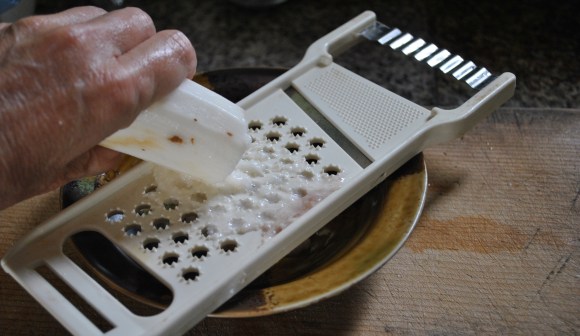
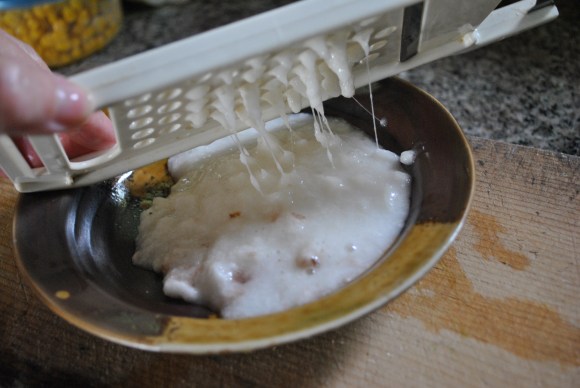
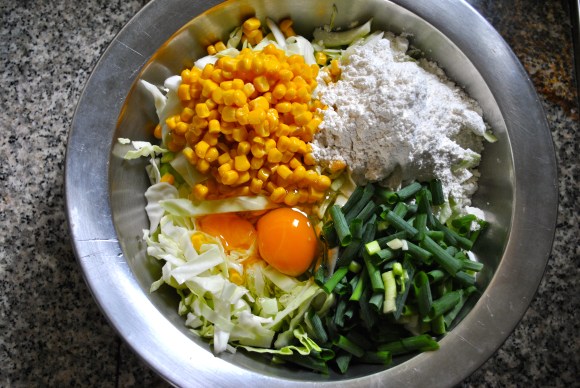
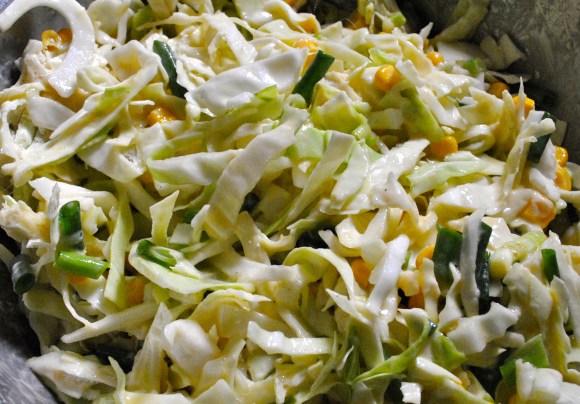
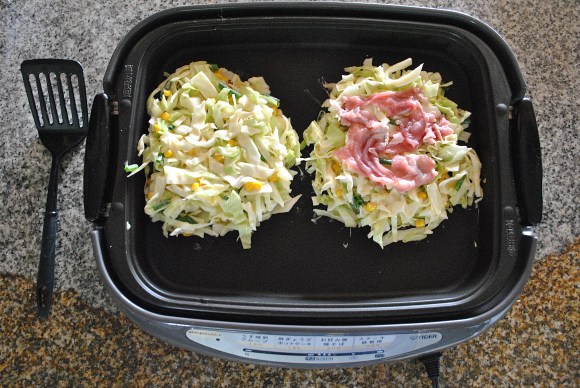
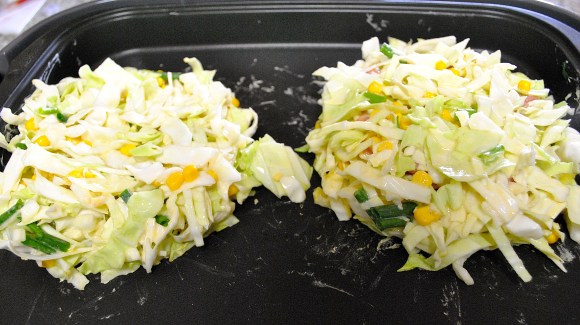
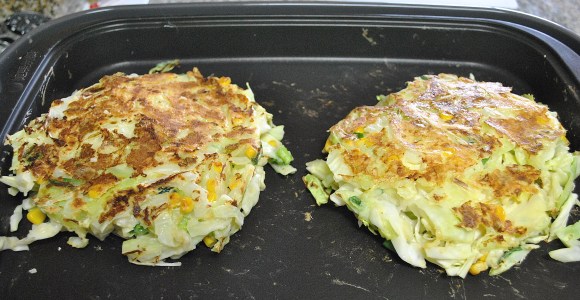
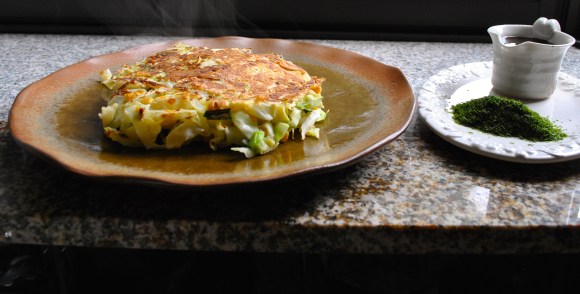
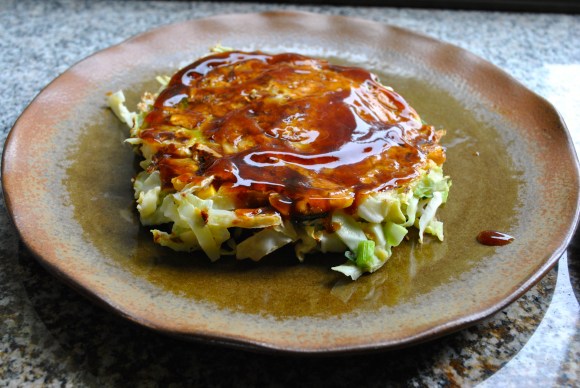
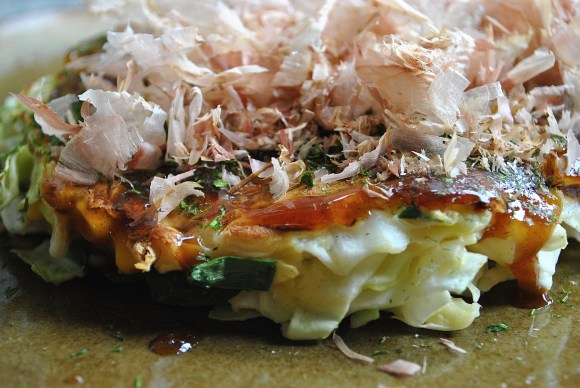
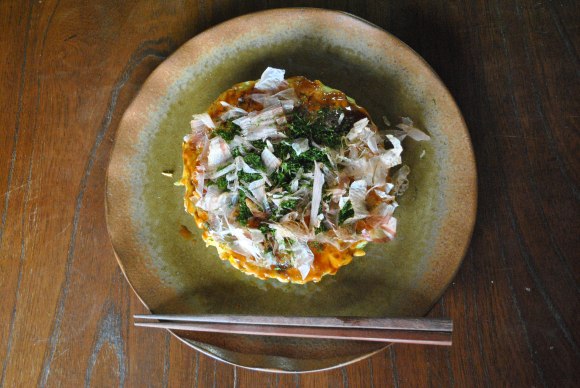
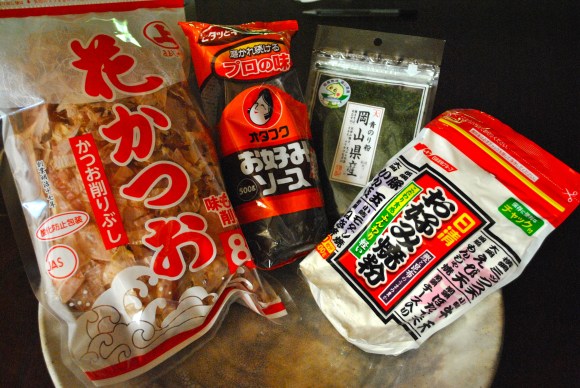
 Rice cooker recipe: How to make a giant cheesy okonomiyaki pancake in a rice cooker
Rice cooker recipe: How to make a giant cheesy okonomiyaki pancake in a rice cooker Microwavable okonomiyaki that you can eat with one hand? Yes, please!
Microwavable okonomiyaki that you can eat with one hand? Yes, please! Okonomiyaki you can eat with one hand? We try a revolutionary new frozen food【Taste test】
Okonomiyaki you can eat with one hand? We try a revolutionary new frozen food【Taste test】 Japanese politician apologizes to prime minister for calling wife’s cooking “Hiroshima-yaki”
Japanese politician apologizes to prime minister for calling wife’s cooking “Hiroshima-yaki” Put a unique twist on your oatmeal by turning it into some Japanese comfort food
Put a unique twist on your oatmeal by turning it into some Japanese comfort food Foreigner’s request for help in Tokyo makes us sad for the state of society
Foreigner’s request for help in Tokyo makes us sad for the state of society Red light district sushi restaurant in Tokyo shows us just how wrong we were about it
Red light district sushi restaurant in Tokyo shows us just how wrong we were about it McDonald’s new Happy Meals offer up cute and practical Sanrio lifestyle goods
McDonald’s new Happy Meals offer up cute and practical Sanrio lifestyle goods Japan’s massive matcha parfait weighs 6 kilos, contains hidden surprises for anyone who eats it
Japan’s massive matcha parfait weighs 6 kilos, contains hidden surprises for anyone who eats it Japanese ramen restaurants under pressure from new yen banknotes
Japanese ramen restaurants under pressure from new yen banknotes Non-ramen Ramen Restaurant Stars: The quest begins at Tokyo’s Oreryu Shio
Non-ramen Ramen Restaurant Stars: The quest begins at Tokyo’s Oreryu Shio Anime girl English teacher Ellen-sensei becomes VTuber/VVTUber and NFT
Anime girl English teacher Ellen-sensei becomes VTuber/VVTUber and NFT Haku is…Chihiro’s dead brother? Studio Ghibli fans blown away by Spirited Away theory
Haku is…Chihiro’s dead brother? Studio Ghibli fans blown away by Spirited Away theory French Fries Bread in Tokyo’s Shibuya becomes a hit on social media
French Fries Bread in Tokyo’s Shibuya becomes a hit on social media Historical figures get manga makeovers from artists of Spy x Family, My Hero Academia and more
Historical figures get manga makeovers from artists of Spy x Family, My Hero Academia and more All-you-can-drink Starbucks and amazing views part of Tokyo’s new 170 meter-high sky lounge
All-you-can-drink Starbucks and amazing views part of Tokyo’s new 170 meter-high sky lounge Studio Ghibli releases new action figures featuring Nausicaä of the Valley of the Wind characters
Studio Ghibli releases new action figures featuring Nausicaä of the Valley of the Wind characters New private rooms on Tokaido Shinkansen change the way we travel from Tokyo to Kyoto
New private rooms on Tokaido Shinkansen change the way we travel from Tokyo to Kyoto Studio Ghibli glasses cases let anime characters keep an eye on your spectacles
Studio Ghibli glasses cases let anime characters keep an eye on your spectacles Tokyo Tsukiji fish market site to be redeveloped with 50,000-seat stadium, hotel, shopping center
Tokyo Tsukiji fish market site to be redeveloped with 50,000-seat stadium, hotel, shopping center Beautiful Ghibli sealing wax kits let you create accessories and elegant letter decorations【Pics】
Beautiful Ghibli sealing wax kits let you create accessories and elegant letter decorations【Pics】 Studio Ghibli releases Kiki’s Delivery Service chocolate cake pouches in Japan
Studio Ghibli releases Kiki’s Delivery Service chocolate cake pouches in Japan New definition of “Japanese whiskey” goes into effect to prevent fakes from fooling overseas buyers
New definition of “Japanese whiskey” goes into effect to prevent fakes from fooling overseas buyers Our Japanese reporter visits Costco in the U.S., finds super American and very Japanese things
Our Japanese reporter visits Costco in the U.S., finds super American and very Japanese things Studio Ghibli unveils Mother’s Day gift set that captures the love in My Neighbour Totoro
Studio Ghibli unveils Mother’s Day gift set that captures the love in My Neighbour Totoro New Japanese KitKat flavour stars Sanrio characters, including Hello Kitty
New Japanese KitKat flavour stars Sanrio characters, including Hello Kitty More foreign tourists than ever before in history visited Japan last month
More foreign tourists than ever before in history visited Japan last month New Pokémon cakes let you eat your way through Pikachu and all the Eevee evolutions
New Pokémon cakes let you eat your way through Pikachu and all the Eevee evolutions Sales of Japan’s most convenient train ticket/shopping payment cards suspended indefinitely
Sales of Japan’s most convenient train ticket/shopping payment cards suspended indefinitely Sold-out Studio Ghibli desktop humidifiers are back so Totoro can help you through the dry season
Sold-out Studio Ghibli desktop humidifiers are back so Totoro can help you through the dry season Japanese government to make first change to romanization spelling rules since the 1950s
Japanese government to make first change to romanization spelling rules since the 1950s Ghibli founders Toshio Suzuki and Hayao Miyazaki contribute to Japanese whisky Totoro label design
Ghibli founders Toshio Suzuki and Hayao Miyazaki contribute to Japanese whisky Totoro label design Doraemon found buried at sea as scene from 1993 anime becomes real life【Photos】
Doraemon found buried at sea as scene from 1993 anime becomes real life【Photos】 Tokyo’s most famous Starbucks is closed
Tokyo’s most famous Starbucks is closed One Piece characters’ nationalities revealed, but fans have mixed opinions
One Piece characters’ nationalities revealed, but fans have mixed opinions We asked a Uniqlo employee what four things we should buy and their suggestions didn’t disappoint
We asked a Uniqlo employee what four things we should buy and their suggestions didn’t disappoint Princesses, fruits, and blacksmiths: Study reveals the 30 most unusual family names in Japan
Princesses, fruits, and blacksmiths: Study reveals the 30 most unusual family names in Japan Shakey’s creates Japanese-style-pizza pizza with new Okonomiyaki Pizza
Shakey’s creates Japanese-style-pizza pizza with new Okonomiyaki Pizza The Fuwatoro Yamaimo Teppan just might be 7-Eleven Japan’s dish of the year【Taste test】
The Fuwatoro Yamaimo Teppan just might be 7-Eleven Japan’s dish of the year【Taste test】 The best and worst Japanese food for foreigners
The best and worst Japanese food for foreigners Be Mr. Sato’s online friend, and he might take you to dinner, like he did with these foreign fans
Be Mr. Sato’s online friend, and he might take you to dinner, like he did with these foreign fans Taco Bell Osaka branches now selling okonomiyaki burritos, promise delicious fusion flavor
Taco Bell Osaka branches now selling okonomiyaki burritos, promise delicious fusion flavor Newly opened restaurant in Osaka boasts a new evolution of okonomiyaki
Newly opened restaurant in Osaka boasts a new evolution of okonomiyaki Okonomiyaki Wine: Japan’s savory pancakes just got a new sidekick
Okonomiyaki Wine: Japan’s savory pancakes just got a new sidekick We test Japanese sweets company’s claim: can one ingredient change pancakes from fluffy to chewy?
We test Japanese sweets company’s claim: can one ingredient change pancakes from fluffy to chewy? We try making a low-calorie katsu with tofu instead of pork【SoraKitchen】
We try making a low-calorie katsu with tofu instead of pork【SoraKitchen】 Kansai and Kanto prove again that they are each distinct regions when it comes to food
Kansai and Kanto prove again that they are each distinct regions when it comes to food How to make epic pancakes with your Japanese rice cooker
How to make epic pancakes with your Japanese rice cooker Flour products sell online for outrageous prices in Japan as demand for them skyrockets
Flour products sell online for outrageous prices in Japan as demand for them skyrockets Bizarre or brilliant? Takoyaki and okonomiyaki rice balls available in convenience stores now
Bizarre or brilliant? Takoyaki and okonomiyaki rice balls available in convenience stores now No time to cook? No problem! Three easy ways to improve instant curry
No time to cook? No problem! Three easy ways to improve instant curry We try making Nisshin’s Jijimi Korean Pancakes in a cup kit【SoraKitchen】
We try making Nisshin’s Jijimi Korean Pancakes in a cup kit【SoraKitchen】
Leave a Reply